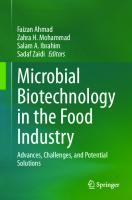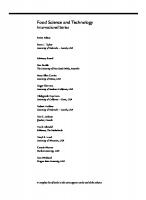seperation process in food and biotechnology industry
468 22 199KB
English Pages 296
Table of contents :
Front Matter......Page 1
Preface......Page 3
Table of Contents......Page 0
Table of Contents......Page 5
1.1 Foods - The Raw Material......Page 11
1.2.1 Introduction......Page 15
1.2.2 Separations from Solids......Page 17
Solid-Solid Separations......Page 18
Separation from the Solid Matrix......Page 19
Liquid-Solid Separations......Page 20
General Liquid Separation Processes......Page 21
1.2.4 Separations from Gases and Vapours......Page 23
1.4 References......Page 25
2.1 Introduction......Page 27
2.2 The Supercritical Fluid State......Page 28
Density......Page 30
Viscosity......Page 31
Diffusion......Page 32
Chemical Properties......Page 33
2.3.1 Solubilities in NCFs......Page 34
General Principles......Page 35
2.3.2 Theoretical Models (Equations of State (EOS))......Page 38
Entrainers......Page 44
2.3.3 Diffusion Coefficients......Page 45
2.4 Factors Determining the Efficiency of NCF Extraction......Page 46
Mechanism of Extraction......Page 47
Adsorption......Page 50
The Role of Water......Page 51
2.4.2 Separation Stage......Page 52
Pilot Plants with Recirculation......Page 54
Small Pilot Plant with Total Loss of CO2......Page 55
2.5.2 Fractionation......Page 56
Zosel's 'Hot Finger' Fractionation Column......Page 57
2.6 Applications......Page 58
2.6.1 Decaffeination of Coffee and Tea......Page 59
2.6.2 Seed Oil Extraction......Page 61
2.6.3 Purification of Lecithin......Page 62
Butterfat......Page 63
2.6.6 Extraction of Flavours and Fragrances......Page 64
2.7 References......Page 67
3.1 Introduction......Page 75
3.2 Terminology......Page 76
3.3 Concentration Factor and Rejection......Page 79
3.4 Membrane Characteristics......Page 80
3.5 Permeate Rate......Page 81
3.6 Transport Phenomena and Concentration Polarisation......Page 82
3.7 Membrane Equipment......Page 85
3.7.1 Membrane Configuration......Page 86
3.8 Safety and Hygiene Considerations......Page 92
3.9.1 Introduction......Page 96
3.9.2 Water Treatment......Page 97
3.9.3 Milk Processing......Page 98
3.9.4 Fruit and Vegetable Juices......Page 100
3.9.5 Other Applications......Page 101
3.10 References......Page 104
4.1 Introduction......Page 107
4.2.1 Rejection or Retention Factors......Page 108
4.2.2 Yield......Page 111
4.2.3 Average Rejection......Page 113
4.2.4 Practical Rejection Data......Page 114
4.3 Performance of Ultrafiltration Systems......Page 115
4.3.1 Transport Phenomena and Concentration Polarisation......Page 116
4.3.2 Fouling......Page 121
Energy Input......Page 124
4.4.1 Washing Out at Constant Volume......Page 126
Washing-in......Page 128
4.4.3 Protein Fractionation......Page 129
4.5 Ultrafiltration Applications......Page 130
4.5.1 Dairy Applications......Page 131
4.5.2 Oilseed and Vegetable Proteins......Page 135
4.5.3 Animal Products......Page 137
4.5.4 Biotechnology Applications......Page 138
4.5.5 Medical Applications: Serum Fractionation......Page 143
4.6 References......Page 144
5.2 Theory, Materials and Equipment......Page 150
5.2.1 Membrane Configurations and Characteristics......Page 151
5.2.2 Performance of Microfiltration Systems and Membrane Fouling......Page 155
5.3.1 Food Industry......Page 157
5.3.2 Applications for Biotechnology......Page 159
5.4 Conclusions......Page 160
5.5 References......Page 161
Solute/Ion-Exchanger Interactions......Page 163
Ion-Exchange Materials......Page 166
Elution......Page 167
6.1.2 Applications of Ion-Exchange in the Food and Biotechnology Industries......Page 168
Demineralisation......Page 169
Protein Purification......Page 171
6.2 Electrodialysis......Page 174
6.2.1 Theory and Equipment......Page 175
6.2.2 Applications of ED in the Food and Biotechnology Industries......Page 177
6.3 References......Page 181
7.1 Introduction......Page 186
7.2.1 Physicochemical Basis for Separation Operations......Page 187
7.3 Liquid-Liquid Extraction: Introduction......Page 188
7.3.1 Aqueous Two-phase Separation......Page 189
7.3.2 Reverse Micelle Extraction......Page 192
7.3.3 Perfluorocarbon Affinity Separations......Page 196
7.3.4 Liquid Membrane Separations......Page 198
7.4.1 Adsorption System......Page 202
7.4.2 Continuous Adsorption Recycle Extraction......Page 203
7.4.3 Membrane Chromatography......Page 206
7.4.4 Chromatographic and Adsorption Materials......Page 208
7.5.1 Electrically Enhanced Separations......Page 209
7.5.3 Purification of Intracelluar Protiens......Page 210
7.6 References......Page 211
8.1 Introduction......Page 214
8.1.1 Crystallisation: Nuclei Formation and Crystal Growth......Page 216
8.1.3 Quality of Edible Oils......Page 217
8.2 Dry Fractionation......Page 218
Florentine Continuous Filter......Page 220
Vacuband Batch Filter......Page 221
8.2.2 Rotary Drum Filters......Page 222
Low Pressure......Page 229
High Pressure......Page 231
Hydrofilter Press......Page 232
8.3.2 Crystallisation......Page 239
8.4 Solvent Fractionation......Page 243
8.5 References......Page 245
9.1 Introduction......Page 249
9.2 Physical Properties of Solids......Page 250
9.2.1 Classification of Powders......Page 252
9.2.2 Particle Size and Particle Size Distribution......Page 253
9.2.3 Particle Density......Page 256
9.2.6 Bulk Density and Porosity......Page 258
9.2.7 Flowability......Page 260
9.3.1 Size Reduction......Page 262
9.3.2 Sieving......Page 264
9.4.1 Introduction......Page 266
9.4.2 Commercial Air Classifiers......Page 268
9.4.3 Process Characterisation......Page 270
9.4.5 Cereal Separations......Page 274
9.4.6 Legumes......Page 276
9.5 Wet Separation Processes......Page 279
9.5.2 Soya Processing......Page 280
9.5.3 Wheat Protein......Page 282
9.5.4 Other Applications......Page 283
9.6.1 Dehulling......Page 284
9.6.3 Cleaning of Raw Materials......Page 285
Colour Sorting and Grading......Page 287
9.7 References......Page 289
Index......Page 293
Front Matter......Page 1
Preface......Page 3
Table of Contents......Page 0
Table of Contents......Page 5
1.1 Foods - The Raw Material......Page 11
1.2.1 Introduction......Page 15
1.2.2 Separations from Solids......Page 17
Solid-Solid Separations......Page 18
Separation from the Solid Matrix......Page 19
Liquid-Solid Separations......Page 20
General Liquid Separation Processes......Page 21
1.2.4 Separations from Gases and Vapours......Page 23
1.4 References......Page 25
2.1 Introduction......Page 27
2.2 The Supercritical Fluid State......Page 28
Density......Page 30
Viscosity......Page 31
Diffusion......Page 32
Chemical Properties......Page 33
2.3.1 Solubilities in NCFs......Page 34
General Principles......Page 35
2.3.2 Theoretical Models (Equations of State (EOS))......Page 38
Entrainers......Page 44
2.3.3 Diffusion Coefficients......Page 45
2.4 Factors Determining the Efficiency of NCF Extraction......Page 46
Mechanism of Extraction......Page 47
Adsorption......Page 50
The Role of Water......Page 51
2.4.2 Separation Stage......Page 52
Pilot Plants with Recirculation......Page 54
Small Pilot Plant with Total Loss of CO2......Page 55
2.5.2 Fractionation......Page 56
Zosel's 'Hot Finger' Fractionation Column......Page 57
2.6 Applications......Page 58
2.6.1 Decaffeination of Coffee and Tea......Page 59
2.6.2 Seed Oil Extraction......Page 61
2.6.3 Purification of Lecithin......Page 62
Butterfat......Page 63
2.6.6 Extraction of Flavours and Fragrances......Page 64
2.7 References......Page 67
3.1 Introduction......Page 75
3.2 Terminology......Page 76
3.3 Concentration Factor and Rejection......Page 79
3.4 Membrane Characteristics......Page 80
3.5 Permeate Rate......Page 81
3.6 Transport Phenomena and Concentration Polarisation......Page 82
3.7 Membrane Equipment......Page 85
3.7.1 Membrane Configuration......Page 86
3.8 Safety and Hygiene Considerations......Page 92
3.9.1 Introduction......Page 96
3.9.2 Water Treatment......Page 97
3.9.3 Milk Processing......Page 98
3.9.4 Fruit and Vegetable Juices......Page 100
3.9.5 Other Applications......Page 101
3.10 References......Page 104
4.1 Introduction......Page 107
4.2.1 Rejection or Retention Factors......Page 108
4.2.2 Yield......Page 111
4.2.3 Average Rejection......Page 113
4.2.4 Practical Rejection Data......Page 114
4.3 Performance of Ultrafiltration Systems......Page 115
4.3.1 Transport Phenomena and Concentration Polarisation......Page 116
4.3.2 Fouling......Page 121
Energy Input......Page 124
4.4.1 Washing Out at Constant Volume......Page 126
Washing-in......Page 128
4.4.3 Protein Fractionation......Page 129
4.5 Ultrafiltration Applications......Page 130
4.5.1 Dairy Applications......Page 131
4.5.2 Oilseed and Vegetable Proteins......Page 135
4.5.3 Animal Products......Page 137
4.5.4 Biotechnology Applications......Page 138
4.5.5 Medical Applications: Serum Fractionation......Page 143
4.6 References......Page 144
5.2 Theory, Materials and Equipment......Page 150
5.2.1 Membrane Configurations and Characteristics......Page 151
5.2.2 Performance of Microfiltration Systems and Membrane Fouling......Page 155
5.3.1 Food Industry......Page 157
5.3.2 Applications for Biotechnology......Page 159
5.4 Conclusions......Page 160
5.5 References......Page 161
Solute/Ion-Exchanger Interactions......Page 163
Ion-Exchange Materials......Page 166
Elution......Page 167
6.1.2 Applications of Ion-Exchange in the Food and Biotechnology Industries......Page 168
Demineralisation......Page 169
Protein Purification......Page 171
6.2 Electrodialysis......Page 174
6.2.1 Theory and Equipment......Page 175
6.2.2 Applications of ED in the Food and Biotechnology Industries......Page 177
6.3 References......Page 181
7.1 Introduction......Page 186
7.2.1 Physicochemical Basis for Separation Operations......Page 187
7.3 Liquid-Liquid Extraction: Introduction......Page 188
7.3.1 Aqueous Two-phase Separation......Page 189
7.3.2 Reverse Micelle Extraction......Page 192
7.3.3 Perfluorocarbon Affinity Separations......Page 196
7.3.4 Liquid Membrane Separations......Page 198
7.4.1 Adsorption System......Page 202
7.4.2 Continuous Adsorption Recycle Extraction......Page 203
7.4.3 Membrane Chromatography......Page 206
7.4.4 Chromatographic and Adsorption Materials......Page 208
7.5.1 Electrically Enhanced Separations......Page 209
7.5.3 Purification of Intracelluar Protiens......Page 210
7.6 References......Page 211
8.1 Introduction......Page 214
8.1.1 Crystallisation: Nuclei Formation and Crystal Growth......Page 216
8.1.3 Quality of Edible Oils......Page 217
8.2 Dry Fractionation......Page 218
Florentine Continuous Filter......Page 220
Vacuband Batch Filter......Page 221
8.2.2 Rotary Drum Filters......Page 222
Low Pressure......Page 229
High Pressure......Page 231
Hydrofilter Press......Page 232
8.3.2 Crystallisation......Page 239
8.4 Solvent Fractionation......Page 243
8.5 References......Page 245
9.1 Introduction......Page 249
9.2 Physical Properties of Solids......Page 250
9.2.1 Classification of Powders......Page 252
9.2.2 Particle Size and Particle Size Distribution......Page 253
9.2.3 Particle Density......Page 256
9.2.6 Bulk Density and Porosity......Page 258
9.2.7 Flowability......Page 260
9.3.1 Size Reduction......Page 262
9.3.2 Sieving......Page 264
9.4.1 Introduction......Page 266
9.4.2 Commercial Air Classifiers......Page 268
9.4.3 Process Characterisation......Page 270
9.4.5 Cereal Separations......Page 274
9.4.6 Legumes......Page 276
9.5 Wet Separation Processes......Page 279
9.5.2 Soya Processing......Page 280
9.5.3 Wheat Protein......Page 282
9.5.4 Other Applications......Page 283
9.6.1 Dehulling......Page 284
9.6.3 Cleaning of Raw Materials......Page 285
Colour Sorting and Grading......Page 287
9.7 References......Page 289
Index......Page 293

- Similar Topics
- Biology
- Biotechnology

![Oils and Fats in the Food Industry (Food Industry Briefing) [1 ed.]
1405171219, 9781405171212, 9781444302431](https://ebin.pub/img/200x200/oils-and-fats-in-the-food-industry-food-industry-briefing-1nbsped-1405171219-9781405171212-9781444302431.jpg)







